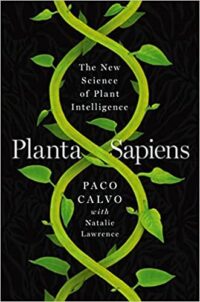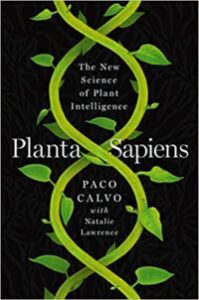What is it like to be a plant?
Planta Sapiens: The New Science of Plant Intelligence
By Paco Calvo with Natalie Lawrence
New York: W.W. Norton, 2023
Reviewed by Casey Dorman
The title of Thomas Nagel’s 1974 paper “What is it like to be a bat?” is often appropriated when a philosopher or scientist wants to muse about the possibility of some creature other than a human being conscious—and self-conscious. Nagel’s point was that consciousness is subjective and unable to be reduced to its physical components, be they a brain or a set of connections in an artificial neural network. Consciousness feels like something. You and I know what it’s like to be us. Probably your dog does too, and also your cat, your goldfish, your parakeet, a tiger stalking its prey in the jungle, a mouse hiding from a prowling cat. There are creatures, however, who are very different from us—bats, in fact, who use echo location rather than sight to navigate, or octopuses whose brains are distributed in their tentacles as well as their heads—and they complicate our usual attempt to understand a member of a species based on an assumption that they think more or less like we do. Even within the animal kingdom, the question arises as to how far down the phylogenetic scale we can go and still impute human-like motives and experiences to creatures such as flatworms, mosquitoes, polyps, bacteria, paramecia, amoeba.
Our tendency to attribute some sort of consciousness to other animals is mostly related to how similar they seem to us. A robot arm doesn’t seem to be aware of itself, but if we construct a human-like robot, an android, with a face and facial expressions and have it carry out human-like actions, it becomes easier to think that it may have an inner experience of being itself. This is why we can identify with Data, the android from Star Trek the Next Generation or Ava in the film Ex Machina. Some scientists and philosophers have not let the lack of similarity to ourselves hinder their exploration of the idea that both intelligence and consciousness exist in living entities far different from ourselves. In his book, The First Minds, psychologist Arthur Reber has suggested that even single cell prokaryotes may be aware of both their surroundings and themselves (2018). 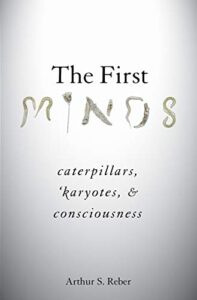 Prokaryotes preceded eukaryotes and if sentience were present in prokaryotes, it ought then to be present in both animals and plants, both of which are eukaryotic. In his book, Planta Sapiens, Paco Calvo, professor of the philosophy of science and principal investigator at the Universidad de Murcia’s Minimal Intelligence Lab (MINTLab) in Spain, and science writer, Natalie Lawrence, have taken this suggestion seriously and written a provocative account of why Calvo thinks plants are not only intelligent, but also conscious.
Prokaryotes preceded eukaryotes and if sentience were present in prokaryotes, it ought then to be present in both animals and plants, both of which are eukaryotic. In his book, Planta Sapiens, Paco Calvo, professor of the philosophy of science and principal investigator at the Universidad de Murcia’s Minimal Intelligence Lab (MINTLab) in Spain, and science writer, Natalie Lawrence, have taken this suggestion seriously and written a provocative account of why Calvo thinks plants are not only intelligent, but also conscious.
Calvo’s thesis is primarily inductive, in that he examines plant movement in vines and root growth, tropisms, electrical conduction, and “defensive” actions such as the closing of leaves and tries to imagine the cognitive “machinery” required to carry out such “behaviors.” His evidence is impressive and sometimes startling. Plants are known to orient toward the sun (you can see this in your own garden), and some plants, such as sunflowers, will orient toward the sun and follow it as it moves across the sky. At night, they re-orient themselves to anticipate the next day’s rising sun. Dig them up and turn them 180 degrees, and within a few days, they will re-orient their movements to match the path of the sun. By doing so, they maximize both photosynthesis and the likelihood of visitation by pollinating insects. Plants will also alter their growth patterns, in terms of their roots and their stems, trunks or leaves, depending on the plants surrounding them, all to the end of maximizing access to resources such as sunlight and nutrients. They can even affect and be affected by the growing conditions of their neighbors, so that they adopt some of each other’s growing patterns. Their roots can alter their direction of growth by turning horizontal or even upward to avoid a barrier, or to seek moisture.
Plants can learn, as demonstrated by the habituation and discrimination learning of leaf-closing in Mimosa pudica, described by both Calvo and Stefano Mancuso in his book The Revolutionary Genius of Plants (2018), which I recently reviewed (Dorman, 2023). 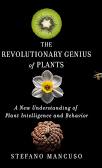 Both Mancuso and Calvo spend a lot of time describing the sensitivity of plants to the same anesthetic chemicals that render animals’ unconscious. Automatic reactions such as leaf-closing in Mimosa pudica or the closing of a Venus Flytrap on an intruding insect are slowed, then stopped, with application of a substance such as chloroform. Not only that, but the electrical impulses that accompany a movement such as the snapping shut of the Flytrap, are muted or absent under anesthesia, similar to interfering with the electrical impulses in an animals’ brains, which are a part of Christof Koch’s indication of consciousness in humans and other animals (Koch, 2015). Not only that, but plants can also respond with chemicals such as dopamine to incidents of damage or destruction, as though they were attempting to relieve pain (which Calvo thinks should lead us to consider the ethical consequences of our actions toward plants).
Both Mancuso and Calvo spend a lot of time describing the sensitivity of plants to the same anesthetic chemicals that render animals’ unconscious. Automatic reactions such as leaf-closing in Mimosa pudica or the closing of a Venus Flytrap on an intruding insect are slowed, then stopped, with application of a substance such as chloroform. Not only that, but the electrical impulses that accompany a movement such as the snapping shut of the Flytrap, are muted or absent under anesthesia, similar to interfering with the electrical impulses in an animals’ brains, which are a part of Christof Koch’s indication of consciousness in humans and other animals (Koch, 2015). Not only that, but plants can also respond with chemicals such as dopamine to incidents of damage or destruction, as though they were attempting to relieve pain (which Calvo thinks should lead us to consider the ethical consequences of our actions toward plants).
The above are just a few of the remarkable findings reported by Calvo in his book. Underlying his hypothesis of plant cognition is the idea that, like humans and other animals, plants’ “phytonervous systems” as Calvo provocatively refers to them, contain models of the plant’s expected environment and base the plant’s actions on sampling the environment and adjusting itself to adapt to the actual environment in order to bring the predicted and the actual conditions as close together as possible. Calvo believes that, similar to animals’ nervous systems, the plant phytonervous system is based on electrical signals being passed from one location to another.
Even if there are similarities between the workings of plants’ and animals’ “nervous systems” (the quotation marks are to acknowledge the fact that plants don’t actually have neurons), Calvo is cautious about over-anthropomorphizing “what it is like to be a plant.” Plants are even less like us than either bats or octopuses. We can try to understand what the plant feels like “from the inside,” but it is doubtful that we will be very successful. But is the whole idea that there is something that it is to feel like a plant even warranted? I have to admit that I came away from reading Planta Sapiens impressed, but not convinced. To his credit, Calvo is a philosopher, but he thinks like a scientist. He expresses most of his conclusions tentatively, and labels them as speculations, not facts. Because of this, I don’t reject his conclusions outright, so much as I doubt them, but, in most cases, I allow that they are possibilities.
Plants display what may be termed “intelligent” behavior, but it is not clear that intelligent behavior requires a conscious agent to produce it. Artificial intelligences also produce intelligent behavior, and the author of Planta Sapiens, as well as other authors such as Arthur Reber, reject the idea that AIs are, or probably ever will be, conscious. Calvo makes a distinction between what he calls “adaptive responses” and those that require cognition. Some of those mentioned above, such as orienting toward the sun, are said to require no cognition on the part of the plant. But the distinction between those responses that require cognition and those that don’t is a fuzzy one. According to Calvo, adaptations are stereotyped, genetically encoded, and reactive, always producing the same response to a stimulus and not subject to modification by different circumstances, however even some of the most prosaic plant behaviors, such as extending roots toward more moist soil can be altered by different conditions. The climbing behaviors of plant tendrils can be described as exploratory searches for suitable objects around which to entwine themselves. Different plants have preferences for the size and color of the objects their tendrils choose as targets. If their target is moved, the tendrils will begin searching and, if possible, locate its new whereabouts and begin climbing anew. Although some plants use circular or ellipsoid motion of the tendrils in their searches, sometimes a plant that has already placed tendrils around a support will cut short a different tendril’s search and go straight to the target instead of using a more circuitous, exploratory route, as though it has learned from his predecessors. This appears to be flexible learning and decision making at work. But what is going on inside the plant that directs such behavior?
When a plant looks as if it’s making a plan based on an internal map, and seems to be making decisions to alter in plan in the face of obstacles, does this require a directing mind to guide the behavior? I am reminded of Peter Robin Heisinger’s statement, “We now have overwhelming evidence that there is no such thing as irreducible complexity in evolved biological structures. Rather, we are dealing with our own brain’s irreducibly failed intuition” (Heisinger, 2021).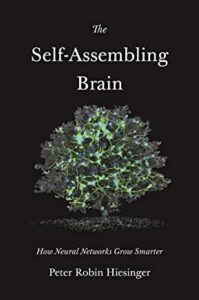 It seems to me that Paco Calvo is prone to assuming that complicated plant behaviors must require a mind to direct them, because such complicated actions could not have been programmed into the plant via its genes. But is that true?
It seems to me that Paco Calvo is prone to assuming that complicated plant behaviors must require a mind to direct them, because such complicated actions could not have been programmed into the plant via its genes. But is that true?
Putting together an animal’s physical structure is complicated. The cells that make up the growing body are sensitive to nutrients, toxins, sights and sounds and a variety of early experiences. One of the most complicated processes in growing a human body is assembling a working brain from the growth of billions of individual neurons. No two brains are alike, because as neurons grow, they interact with the idiosyncrasies of the experiences of the organism that houses them. Their growth is determined by genes, but the genes produce a modifiable plan, and the elements that can modify it affect the selection of the genes that control the neuron’s growth, so that it looks as if it has a mind. A neuron doesn’t have a mind and is not, by itself conscious. It grows by following an algorithm that allows it to modify its growth pattern according to the circumstances of its owner’s experiences (Heisinger, 2021). Probably, roots follow similar genetically based algorithms and the tendrils of vines do also. Those algorithms were chosen because they produced a plant that was likely to survive in a certain environment. The plant itself doesn’t need to know what it’s doing to survive. Its components just need to follow a plan that was shaped by evolution.
I’m a skeptic and I have biases. In my opinion, the author of Planta Sapiens has leapt into the gap formed by our lack of knowledge of how and why plants do what they do and inserted an assumption that would fit a cognitive being. I don’t think that’s merited, although that doesn’t mean it isn’t correct. My bias is to limit minds and consciousness to more complicated, brain-possessing creatures. But I may be anthropomorphizing, because when I think of a mind, I think of a human mind, and, as Calvo reminds us, there’s no reason to think that, if a plant had a mind, it would resemble a human one in any way we can think of. Arthur Reber makes a strong argument for even single-cell creatures being aware of what impinges on them from their environment, that is, having something akin to sensations. If he’s right, then perhaps even plants are aware of some parts of their environment and can sense when it impinges upon them. Depending on what we mean by “sense,” that could mean they are conscious. I don’t think so, but Calvo has at least opened my mind to the idea.
References
Dorman, C. (2023). Genius in Your Garden. A Review of Stefano Mancuso’s “The Revolutionary Genius of Plants.” https://caseydorman.com/the-genius-in-your-garden/
Heisinger, P.R. (2021). The Self-Assembling Brain: How Neural Networks Grow Smarter. Princeton, N.J. Princeton University Press.
Koch, C. (2015). The Feeling of Life Itself: Why Consciousness is Widespread but Can’t be Computed. Cambridge, MA: MIT Press.
Mancuso, S. (2018). The Revolutionary Genius of Plants: A New Understanding of Plant Intelligence and Behavior. New York: Atria Books.
Reber, A.S. (2018). The First Minds: Caterpillars, Karyotes and Consciousness. London: Oxford University Press.
Read Ezekiel’s Brain on Amazon. Available in paperback and Kindle editions
Rather listen than read? Download the audio version of Ezekiel’s Brain from Books in Motion.
Subscribe to Casey Dorman’s Newsletter. Click HERE
